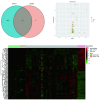Impact of Physical Activity, Sedentary Behavior, and Basal Metabolic Rate on PTSD, Depression, and Emotional Instability
- PMID: 39595834
- PMCID: PMC11592194
- DOI: 10.3390/brainsci14111071
Impact of Physical Activity, Sedentary Behavior, and Basal Metabolic Rate on PTSD, Depression, and Emotional Instability
Abstract
Objective: This study aimed to investigate the potential associations between physical activity, sedentary behavior, and the basal metabolic rate (BMR) with post-traumatic stress disorder (PTSD), major depressive disorder (MDD), and emotional instability (EI) using bidirectional Mendelian randomization (MR). Additionally, it sought to identify key molecular mechanisms underlying emotional instability through a comprehensive bioinformatic analysis.
Methods: MR analyses utilizing genome-wide association study (GWAS) data were conducted to estimate the effects of physical activity, sedentary behavior, and the BMR on PTSD, MDD, and EI. Sensitivity analyses were performed to assess the robustness of the findings. Concurrently, a bioinformatic analysis was executed on gene expression datasets (GSE53987 and GSE21138) derived from emotionally unstable patients. This analysis encompassed the differential gene expression analysis to identify differentially expressed genes (DEGs), followed by an functional enrichment analysis to uncover key molecular pathways associated with EI.
Results: The MR analysis revealed that increased physical activity may have a protective effect against PTSD, albeit with inconsistent effects on MDD and EI. Sedentary behavior and the BMR demonstrated minimal associations with PTSD, MDD, or EI. The bioinformatic analysis identified 114 DEGs associated with EI, with YWHAB, SRRM2, MST1, HDAC10, and HSPA1A highlighted as significant genes. The functional enrichment analysis of these DEGs unveiled key pathways potentially involved in the molecular pathology of emotional instability.
Conclusions: Physical activity appears to protect against PTSD, whereas its effects on MDD and EI are less definitive. The bioinformatic findings offer a deeper molecular understanding of EI, pinpointing specific genes and pathways that may serve as potential therapeutic targets. Further research is warranted to elucidate these intricate interactions and the identified molecular mechanisms.
Keywords: basal metabolic rate; bioinformatics; differential gene expression; emotional instability; major depressive disorder; physical activity; post-traumatic stress disorder; sedentary behavior.
Conflict of interest statement
The authors declare no conflicts of interest.
Figures




References
-
- Sharma A.K., Jain K., Mulchandani K., Sorte S.R., Rathod S.B., Vij V., Gumashta J. Navigating the challenges: Exploring the association between COVID-19 lockdowns and eating behavior in university students: A systematic review and investigation of factors impacting ed levels. Horm. Mol. Biol. Clin. Investig. 2024;45:85–98. doi: 10.1515/hmbci-2023-0049. - DOI - PubMed
-
- Asch R.H., Worhunsky P.D., Davis M.T., Holmes S.E., Cool R., Boster S., Carson R.E., Blumberg H.P., Esterlis I. Deficits in prefrontal metabotropic glutamate receptor 5 are associated with functional alterations during emotional processing in bipolar disorder. J. Affect. Disord. 2024;361:415–424. doi: 10.1016/j.jad.2024.06.025. - DOI - PMC - PubMed
LinkOut - more resources
Full Text Sources
Research Materials
Miscellaneous

